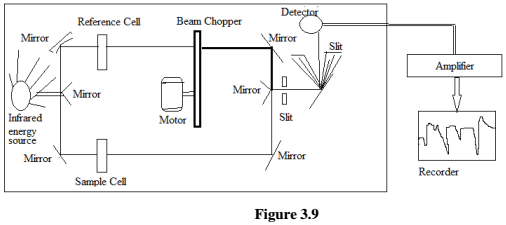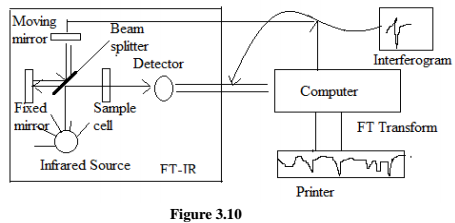Q.2. (a) Draw line diagrammes and discuss mode of operation of dispersive and interferomatric IR instruments with their merits & demerits.
Ans.2. (a) Mode of operation of dispersive IR instrument

The dispersive IR instrument shown in figure 1.7produces a beam of infrared radiation from a hot wire and, by means of mirrors, divides it into two parallel beams of equal intensity radiation. The sample is placed in one beam, and the other beam is used as a reference. The beams then pass into the monochromator, which disperse each into a continuous spectrum of frequencies or infrared light. The monochromator consists of a rapidly rotating sector (beam chopper) that passes the two beams alternatively to a diffraction grating (a prism in older instruments). The slowly rotating diffraction grating varies the frequency or wavelength of radiation reaching the thermocouple detector. The detector senses the ratio between the intensities of the reference and sample beam. In this way, the detector determine which frequency have been absorbed by the sample and which frequency are unaffected by the light passing through the sample. After signal from the detector is amplified, the recorder draws the resulting spectrum of the sample on a chart. Disperse instruments are said to record a spectrum in the frequency domain.
Merits of disperse IR instruments:
1. There are a many moving parts resulting in mechanical slippage and wear.
2. In order to improve resolution only a small amount of the IR beam may be allowed to pass the through the slits.
3. Only radiation of a narrow frequency range falls on the detector at any one time.
4. Any emission of IR radiation by the sample will fall on the detector.
5. The instrument automatically “subtracts’’ the spectrum of the solvent from that of the sample.
6. The instrument also cancels out the effect of the infrared-active atmospheric gases, carbon dioxide and water vapour, from the spectrum of sample.
Demerits of Disperse IR instruments:
1. It is a slow scanning process and therefore time consuming also.
2. There is limited energy throughput because the optical dispersion process throws energy away and the exist and entrance slits allow throughput of only a small fraction of the total IR energy.
3. It is difficult to increase the S/N by multiple scanning because the wavelength reproducibility is not sufficient due to mechanical irrelevant response.

Mode of operation of Interferometer
In the interferometerIR instrument shown in figure1.8, the source of energy passes through the a beam splitter, a mirror placed at a 45º angle to the incoming radiation, which to the incoming radiation to pass through but separates it into two perpendicular beam, one undeflected, the other oriented at a 90º angle. One beam the one oriented at 90º, goes to a stationary or fixed mirror and is returned to the beam splitter. The undeflected beam goes to a moving mirror and is also returned to the beam splitter. The motion of the mirror causes the path length that the second beam traverses to vary. When the two beams meet at the beam splitter, they recombine, but the path length difference of the two beams causes both constructive and destructive interference. The combined beam containing these interference patterns is called the interferogram. This interferogram contains all of the radiative energy coming from the source and has a wide range of wavelengths.
Merits of Interferometer
1. Only mirror moves during an experiments.
2. Use of laser provides high frequency accuracy.
3. Stray light does not affect the detector, since all signals are modulated.
4. A much larger beam may be used at all times. Data collection is easier.
5. Rapid scan speed permit monitoring sample undergoing rapid change.
6. The sample is not subject to thermal effects.
7. Any emission of IR radiation by the sample will not be detected.
Demerits of Interferometer
1. It is a very complicated process.
2. It is expensive to build










.png)

